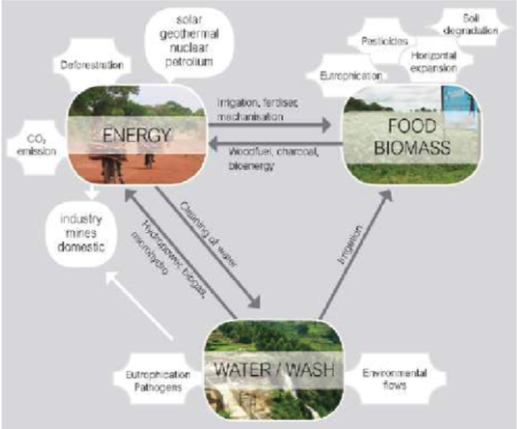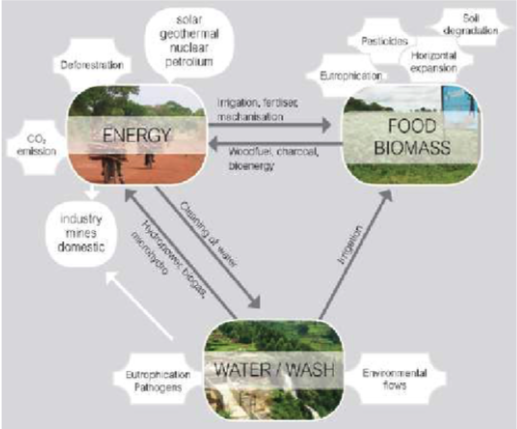Reconciling Water, Energy and Agricultural Sector Demands in Zambia

Key Messages
- The pressure on natural resources and increasing demand for food, water and energy in Zambia are largely due to the increaisng population and expanding urban middle class.
- The Food-Energy-Water nexus study provides policy makers with a holistic quantitative assessment that shows different strategies.
- Agricultural transformation and energy transition are interdependent and partly also compete for the same resources, e.g. water and biomass.
Introduction
This case study is from theFRACTAL Adaptation Inspiration Book– this link provides a summary of the book, the other case studies and a downloadable pdf.
This project addresses the interconnected water, energy and food development challenges in Zambia at different levels, to enable decisionmakers to work together to meet human aspirations.
GFA Consulting Group and the Stockholm Environment Institute (SEI) joined forces in the pilot study to assess the Water-Energy-Food (WEF) nexus in Zambia from a governance and bio-physical perspective.
The objectives were to explore whether a nexus perspective could add value to the implementation of the current policy framework, and to guide new policy development in Zambia (zur Heide et al., 2015).
The FRACTAL Adaptation Inspiration Book contains a variety of case studies which are related to this case study, examining adaptation of urban water resources, agriculture and energy. The related articles can be found here:- Off-Grid Power Generation Solutions in the Takoradi Region, Ghana
- Urban Agriculture: Improved Governance for Resilience in Bulawayo, Zimbabwe
- Meeting Ethiopia’s Development Goals by Addressing Links between Water, Energy and Food
- Africa’s First Direct Water Reuse Plant in Windhoek, Namibia
- Tackling Soil Erosion and Improving Lives in South- Eastern Nigeria
- Cape Town, South Africa: An integrated approach to river catchment management
- Lesotho: Tackling water insecurity: an assessment of future national water management
- Ensuring Future Water Security through Direct Potable Reuse in Windhoek, Namibia
Climate Risks and Other Stressors
Zambia depends heavily on its natural resources. Climatic hazards such as droughts and floods threaten the wellbeing of its physical and biological systems.
This puts considerable stress on the development of sensitive sectors – including agriculture and food security, wildlife, forestry, water and energy, and human health. These sectors also affect the economic, social, and environmental dimensions of Zambia’s sustainable development.
The primary concern of the government is to protect its people, infrastructure, and other national assets against disasters and climatic hazards.
Therefore, in order to respond to disasters at the national level, the government established the National Disaster Management Policy and the Disaster Management and Mitigation Unit under the Office of the Vice President. The government is also committed to ensuring that vulnerable communities receive needed support with safety-net initiatives, which will enhance their adaptive capacity, and reduce their vulnerabilities.
Link to SDGs

The implementation of a nexus perspective would address the subjects of food, water and energy security (SDGs 2, 6 and 7) for all in an innovative manner (SDG 9) and at the same time meet the uncertainties under a changing climate, building resilience of communities to climate-related hazards (SDG 13).
Challenges

A growing population (from the current 14.5 million people to an expected 25 million people in 2030), and an expanding urban middle class increase the demand for food, energy and water, and subsequently the pressure on natural resources. For instance, deforestation and unmet environmental flow requirements are two examples of current unsustainable resource exploitation in Zambia. Climate change is exacerbating these already difficult and complex issues.
Meeting the water demand of the Zambian population and the sector in general requires big investments into storage for water for irrigation and hydropower generation. Future expansion of irrigated agriculture and hydropower production will most likely lead to conflicting interests between the agriculture and water sectors, in particular during the dry season (March/April) when water demands peak.
With regard to energy security, the analysis suggests that only parts of the future energy demand can sustainably be met by hydropower, suggesting that biomass will continue to play a major role in the energy sector.
Food security remains a challenging issue in many parts of Zambia. The current agriculture sector predominantly consists of small-scale, low-yielding farms, and a few large-scale, input-intensive commercial farm enterprises. With a growing urban middle class and increasing agricultural exports, Zambia’s demand for food is rising. As a response, agriculture is gradually intensifying (e.g., maize, sugar cane, tobacco and wheat) and expanding into forestlands, while the government recently started a programme to build commercial farm blocks to attract large-scale investment.
Benefits
The Food-Energy-Water nexus study highlighted the interdependencies of these different sectors in the face of climate change. However, it also showed that these interdependencies can contribute to a sustainable development trajectory of Zambia if decision-makers on a regional and national level can make informed decisions that capitalise on the most promising pathways.
The study provides policy makers with a holistic quantitative assessment that shows possible pathways, but also trade-offs of adaptive measures and different strategies.
Lessons Learnt
- The study showed that agricultural transformation and energy transition are interdependent and partly also compete for the same resources, e.g. water and biomass.
- Increasing agricultural intensification also results in increasing energy demand. However, there is potential to increase the production of energy by using biomass from croplands for bioenergy.
- The future development goals for the country show conflicting sector policies. For example, intensified agricultural systems may be in conflict with sustainable water use.
- To attain the envisioned development trajectories, integrated quantitative assessments need to be conducted.
- The Sector Advisory Groups meetings need to take a more proactive approach towards new implementation projects.
Related resources
- FRACTAL - Inspiring Climate Action in African Cities - find more inspiring cases
- FRACTAL website
- Off-Grid Power Generation Solutions in the Takoradi Region, Ghana
- Urban Agriculture: Improved Governance for Resilience in Bulawayo, Zimbabwe
- Meeting Ethiopia’s Development Goals by Addressing Links between Water, Energy and Food
- Africa’s First Direct Water Reuse Plant in Windhoek, Namibia
- Tackling Soil Erosion and Improving Lives in South- Eastern Nigeria
- Cape Town, South Africa: An integrated approach to river catchment management
- Lesotho: Tackling water insecurity: an assessment of future national water management
- Ensuring Future Water Security through Direct Potable Reuse in Windhoek, Namibia
(0) Comments
There is no content